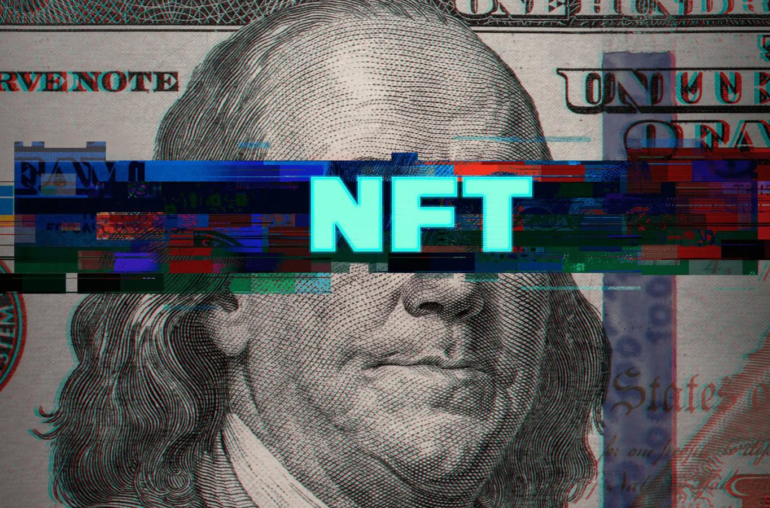Introducing Grid
We’re a new publication dedicated to reporting on how the most important trends, challenges and opportunities of the day connect to one another – and require connected solutions. Learn more.
Follow
Introducing Grid Health, our new weekly health and policy newsletter
People take photos by a Bored Ape Yacht Club NFT billboard in Times Square during the NFT.NYC conference on June 23 in New York.
NOAM GALAI/Getty Images
And is media even a good fit for this medium?
Technology Reporter
Evidence is mounting that the internet’s NFT gold rush is over.
As recently as this summer, these digital files — properly known as non-fungible tokens — were trading for hundreds of thousands of dollars. Collectors eagerly snapped up NFT versions of everything from cat memes and the cartoon monkeys of the Bored Ape Yacht Club to serious artwork, all preserved on the same blockchain technology that underlies cryptocurrency. That changed this summer: From May to July, the average NFT sale price dropped from $3,894 to $293.
Meanwhile, some of the most prominent names in news, who recently began selling NFT versions of historic news stories or photos, have ended those efforts. CNN last week shuttered its NFT project, the Vault, which marketed digital assets to people of news clips, highlights and seminal moments — including an NFT of its short-lived streaming service, CNN+.
The closure calls into question the viability of other latecomers to the NFT craze — such as the Associated Press Marketplace, through which the wire service sells NFTs of award-winning photographs.
ADVERTISEMENT
More broadly, experts told Grid that the recent NFT slump helps undermine the long-standing notion that it and other Web3 technologies — such as cryptocurrency — are immune to larger financial and economic trends. Companies like CNN and AP jumped onto the NFT trend when it seemed a much surer bet to make a quick buck. The picture now, amid fears that recession is coming, is much different.
“This was a jump on a bandwagon,” said Shelly Palmer, professor of advanced media in residence at the SI Newhouse School of Public Communications at Syracuse University, of the CNN NFT effort. “Someone was probably at a golf course and said, ‘I guess we need to have NFTs, let’s do it.’ That’s what this was. And honestly, how of all the things that have value in the world as digital assets or digital collectibles, would a moment of completely public domain news footage qualify?”
After exploding in popularity the last few years, NFTs have been on the decline for months. Recent data shows NFT trading volume is down 97 percent from its January peak — from around $17 billion in January to about $460 million in September. Numerous projects spun up to ride the trading wave have since washed out in the surf.
CNN said in a statement that its NFT marketplace was initially planned as a six-week experiment. But users and other reports point out that the scope had expanded well beyond that timeline and included mentions of “future drops” and exclusive access to events.
The company has said it will compensate people who purchased NFTs with one-time payments of Flow coin, a cryptocurrency based on the same blockchain that CNN used for its NFTs. In the project’s Discord group, a CNN staffer told members that “we are currently working out the details, but expect the distribution amount to be roughly 20% of the original mint price for each Vault NFT owned.”
ADVERTISEMENT
The actual media would be stored on the Interplanetary File System, a distributed storage network that means the media associated with each NFT would exist even if CNN’s website was deleted.
Still, a large part of NFT projects are the communities that are built up around them — and parts of the CNN community feel burned, alleging the shutdown was akin to a “rug pull” in which a project takes supporters funds and then shuts down, taking supporters money with them. More broadly, as NFTs have become more popular, the people buying them are less likely to understand the environment they’re walking into.
“NFT’s are just receipts,” said Palmer. “My favorite slide in my favorite speech is a picture of a Bored Ape on one side and an ERC 721 [a data standard for creating an NFT] on the other. And the title of slide is ‘one of these is not an NFT.’ Everybody thinks the JPEG is the NFT — it’s nonsense.”
CNN said it would also burn all unsold NFTs, hypothetically making the ones it has already sold more valuable.
Twitter user @Benjamin23, who bought Vault NFTs, said he did so to own a historic collectible. For example, the CNN news clip that depicts the moment Barack Obama won the presidency represents a core memory of his and is an appealing collectible to him personally.
ADVERTISEMENT
“The fact that CNN decided to shut down their NFT project is disappointing, not so much because we need more NFTs but because it indicates they were only interested in short-term profits,” he said. “Companies like Dapper Labs, which partnered with CNN to launch their NFTs, have only shown their commitment to generating profits. They haven’t yet shown a commitment to building something sustainable that benefits holders of their NFTs.”
It also opens questions about why established companies have decided NFTs were a business they should get into.
Palmer, who also owns a Web3 consulting company, said that his first question to every single client is “Why is blockchain a better solution for the business outcome you seek than a well-structured database with a secured password?”
And if they can’t answer that question, he wonders if they even have a database strategy more generally.
“You would be surprised how many people just need to have a blockchain project right now,” Palmer said. “Or just need to have an NFT project.”
NFTs might lend themselves well to media and news, according to multiple experts. Omid Malekan, an adjunct professor at Columbia Business School who teaches courses on crypto and blockchain, thinks it makes sense when preserving a specific moment — he’s old enough to remember when the cover of Time magazine really meant something and people even collected these things.
“A problem though is I think a lot of the traditional media outlets don’t understand the world and they do dive right in without having a long-term game plan,” said Malekan. “Because it seems they do not understand the second part of NFTs and collectibles. They’re all about building a community around those and NFTs and collectibles. And building communities takes time and engagement and a lot of investment.”
Many NFT-watchers have suggested that the market for these files has followed the classic pattern of an economic bubble. That often results in many people being harmed, Malekan said, but bubbles do serve an important purpose — helping to build out physical infrastructure and cultural infrastructure. In this case, an NFT bubble could result in better digital wallets for storing NFTs or people being better able to program NFTs.
“What CNN and the others who’ve done this kind of fly-by-night NFT issuance failed to understand is that everything in our world is about community,” said Malekan. “As cold and digital and unforgiving as crypto could be, it really is about bringing people together. And you need to always do that in good faith. There’s even a way to do it in good faith, even when you fail spectacularly.”
Thanks to Lillian Barkley for copy editing this article.
Technology Reporter
Benjamin Powers is a technology reporter for Grid where he explores the interconnection of technology and privacy within major stories.
TOPICS
Sign up for Grid Today and get the context you need on the most important stories of the day.


